Motorola Droid X2 Review - A Droid X with Tegra 2
by Brian Klug on July 7, 2011 8:31 AM ESTWiFi and Cellular Connectivity
The X2’s included cellular connectivity is the standard fare for Verizon in the USA. That means 800 / 1900 MHz 1x and EVDO Rev.A for the cellular side supplied courtesy a Qualcomm MDM6600. There's no GSM or UMTS connectivity for if you travel abroad. As a refresher, the Droid X used a Qualcomm QSC6085. I think the X2 hasn’t seen as much attention as its predecessor primarily because it doesn’t include any LTE connectivity. On the brighter side, you get better battery life as a result.
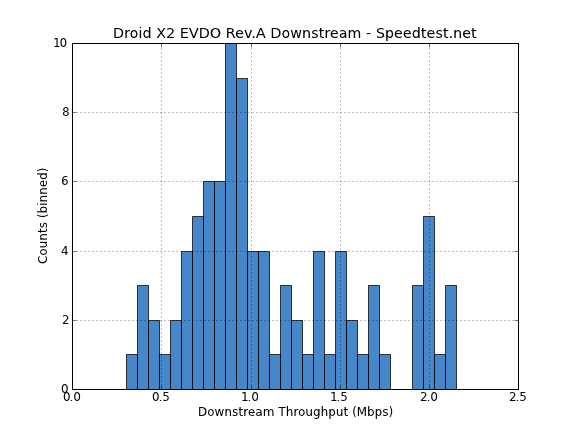
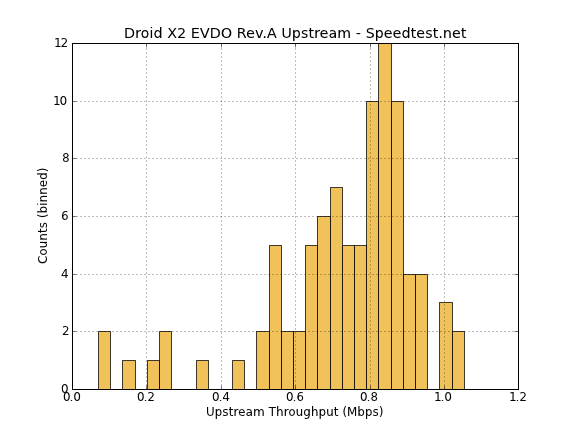

I ran just shy of 100 speedtests on the X2 and created histograms as always. Let me just say that it’s hard coming down off of LTE’s order of magnitude faster performance to EVDO Rev.A, seriously. Downstream performance is between 0.5 and 2 Mbps, about what I’m used to seeing for Verizon’s EVDO Rev.A network. Upstream is centered around an admittedly fast 0.8 Mbps. Latency has a bunch of erroneous results clustered down in the single digit ms response times which are just the speedtest.net application glitching out for some reason.
I neglected to put the X2 through our attenuation test suite, but again the device has receive diversity with cellular antennas at the top and bottom of the handset and should perform just as well as the first device. Likewise I didn’t notice any unwarranted drops in signal while using the handset and holding it. Over in field test (##program followed by 000000), the X2 reported signal usually within 1-2 dBm of the original Droid X.
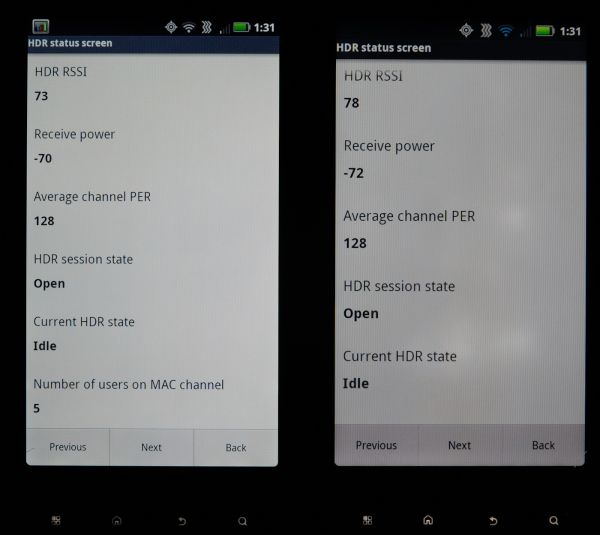 Left: Droid X2, Right: Droid X
Left: Droid X2, Right: Droid X
If you’ve been reading any of our smartphone reviews, you should be able to guess what WLAN and BT chipset is inside the Droid X2. Yes, it’s another smartphone with Broadcom’s BCM4329 combo chip, which means it has 802.11n single stream support on 2.4 GHz.
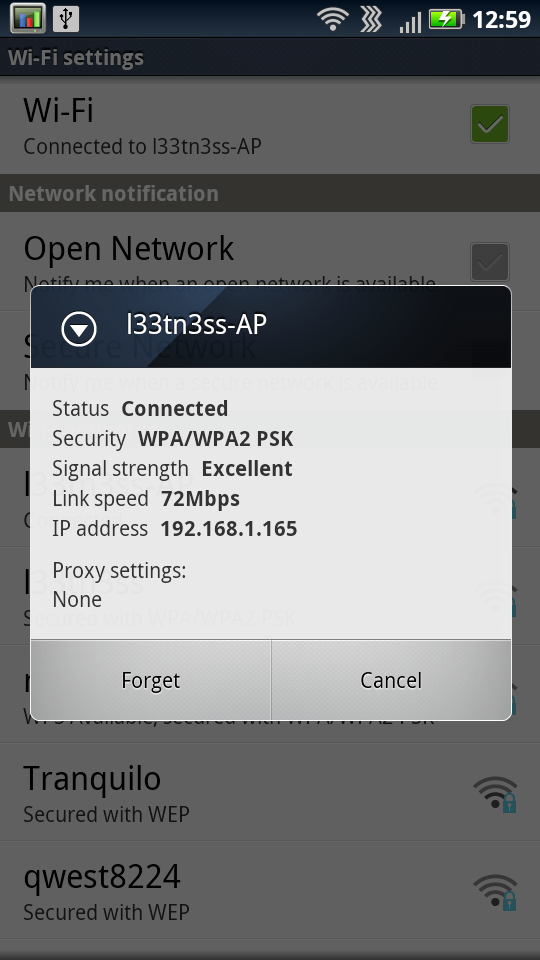
Performance is pretty speedy on our WiFi transfer test which consists of a 100 MB PDF being downloaded from a local server. WiFi range is also virtually unchanged from the Droid X, again I walked around my house with RSSI visible and watched the X and X2 sit within 1-2 dBm of each other, odds are it's the same antenna inside.
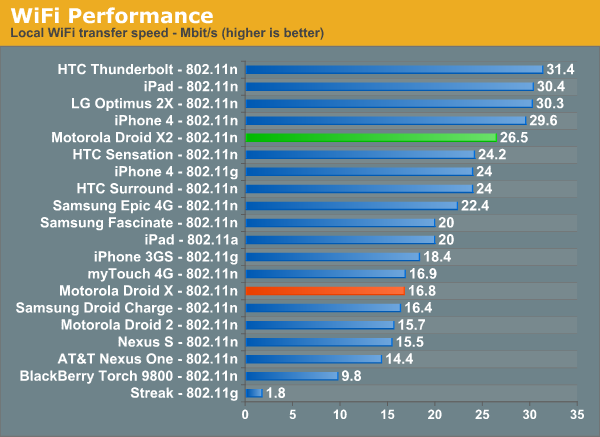
Things have indubitably sped up in part due to the X2's WLAN stack giving the 72 Mbps short guard interval rate instead of 65 Mbps long guard interval 802.11n speeds on the X.










72 Comments
View All Comments
HangFire - Thursday, July 7, 2011 - link
Far be it from me to defend Apple, but this has little to do with them. The popularity of streaming media- made possible by WiFi, 3G, 4G, and pocketable 720P level resolution screens, has made phones mini media devices, and as for viewing media on screens, the bigger the better.I like a small phone, and a large TV screen. The market is in the process of discovering just what compromise people want, and don't want, in terms of size.
Anyway, the current 3.5" screen iPhone is smaller (and more phone-like) than these 4.3" mini-tablets.
jonup - Friday, July 8, 2011 - link
I was not bad talking Apple so no point to defend them. I was inferring to the fact that the iPhone revolutionalized/popularized the "mini media devices". I was just a little facetious but thats my style. ;pThat said I am left with virtually no upgrade options unless I want to spend $1000+.
strikeback03 - Thursday, July 7, 2011 - link
Did you retest the talk time for the original X? Or is your friend's X an early one? I got mine at the beginning of March, and the web browsing tests look similar to what I would expect from my phone (what do you set the screen brightness to?) but I don't think it could get anywhere near 8.9 hrs of calling. I'm used to seeing it drop 10% for 15-20 minutes of calling.jmcb - Thursday, July 7, 2011 - link
Being in a good or bad reception area will have an effect on battery life. Are you in a bad reception area?Brian Klug - Thursday, July 7, 2011 - link
I'm definitely aware of how much of a difference that can make, and we always test in moderate to good coverage areas. In this particular test area, VZW signal (both 1x and EVDO) are above -70 dBm, which is pretty good. I believe there's a screenshot or two that show -70 dBm and -65 dBm.-Brian
strikeback03 - Friday, July 8, 2011 - link
My Elixir icon shows less helpful stuff like "65%", so not sure what kind of reception in dBm I'm seeing. Though on further reading I doubt it would hit the WiFi browsing time either, with the screen on at my standard 12% brightness and all radios off I don't think it would last almost 9 hrs.strafejumper - Thursday, July 7, 2011 - link
I see the Motorola Droid 3 is up for order now on Verizon!Is the Droid 3 the next version of the phone in this review? Or a different animal?
If its the next in the same line its pretty funny that by the time a good review comes out for the phone the next one is already available to order!
Maybe with android phones if you wait for a thorough review you will be outdated before you have the phone in hand!
http://www.engadget.com/2011/07/07/motorola-droid-...
strikeback03 - Thursday, July 7, 2011 - link
It is more or less they same phone in a different form factor. Same as the Droid 2 and Droid X were closely related.strikeback03 - Thursday, July 7, 2011 - link
MY apologies, Droid 3 isn't Tegra 2, it is OMAP 4430. Brain fart. Anyway, it is still more a supplement than a replacement to the Droid X2LoneWolf15 - Friday, July 8, 2011 - link
Actually, the Droid 3 replaces the Droid 2, just as the Droid X2 replaces the Droid X.For those of us who still like tactile keyboards (like myself), the Droid 3 is the preferable phone.